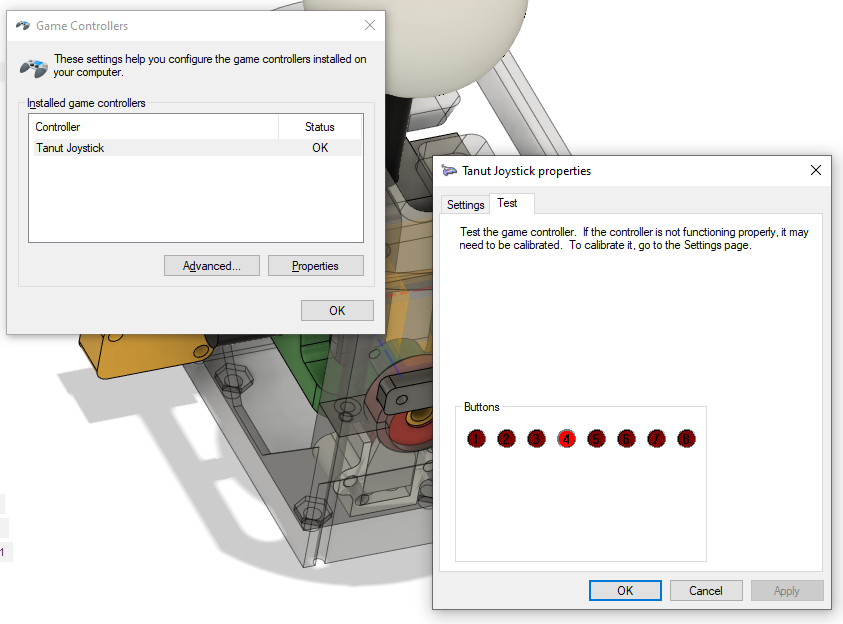STM32 USB HID Joystick first test!

It’s a small step for me towards creating my own USB device. For this particular project, I wanted to create a sim racing shifter which I have somewhat develop the mechanism couple of weeks ago. (Work in progress)
Download the 3D models of the gear shifter (STEP file) from Here
Back to the USB Joystick, I use STM32F103C8 (the blue pill) because
- I learn that they are cheap ~4USD
- It can works as a usb device which my favorite Arduino Uno doesn’t. I don’t have a very deep understanding on this topic but I learnted that Arduino Uno has USB to serial chip sits in between USB and the Atmel processor, so the computer (host) see it as serial device. Where as STM32 has a usb port connected directly to the controller, that USB can be anything you wish. The main draw back is that STM32 can’t be programmed easily without bootloader.
- To step up my microcontroller journey, I have heard many benefits of STM32.
How to setup STM32 for USB HID Joystick
I learned most the following steps from this youtube clip https://youtu.be/tj1_hsQ5PR0 Then I made some changes to make the precess suitable for “joystick” instead of “keyboard”
-
On IOC file
-
Pinout & Configuration tab
- Go to “RCC”, set “High Speed Clock” to “Crystal/Ceramic”
- Go to “SYS”, set “Debug” to “Serial Wire”
- Go to “USB”, check “Device (FS)”
- Go to “USB_DEVICE”, on “Class For FS IP” select “Human Interface Device”
-
Clock Configuration tab
- Press resolve clock issue
- Set HCLK to 72 MHz
-
Save the file
-
-
Open “usbd_hid.c” located in Middlewares > ST > STM32_USB_Device_Library > Class > HID > Src > usbd_hid.c
- Find this line
0x02, /*nInterfaceProtocol : 0=none, 1=keyboard, 2=mouse*/and change the original value 0x02 (for mouse) to 0x00 for joystick
-
Find this code section
__ALIGN_BEGIN static uint8_t HID_MOUSE_ReportDesc[HID_MOUSE_REPORT_DESC_SIZE] __ALIGN_END = { ... };All original content inside is an example of a mouse USB descriptor. Delete them and replace with our simple USB descriptor for a joystick.
0x05, 0x01, //; USAGE_PAGE (Generic Desktop) 0x09, 0x05, //; USAGE (Gamepad) 0xA1, 0x01, //; COLLECTION (Application) 0x05, 0x09,// ; USAGE_PAGE (Button) 0x19, 0x01, //; USAGE_MINIMUM (Button 1) 0x29, 0x08, //; USAGE_MAXIMUM (Button 8) 0x15, 0x00, //; LOGICAL_MINIMUM (0) 0x25, 0x01, //; LOGICAL_MAXIMUM (1) 0x75, 0x01, //; REPORT_SIZE (1) 0x95, 0x08, //; REPORT_COUNT (8) 0x81, 0x02, //; INPUT (Data,Var,Abs) 0xC0,// ; END_COLLECTIONIn fact this descriptor is generated from a software called “HID Descriptor Tool” which can be downloaded from https://www.usb.org/hid . To have better understanding on how to create a custom destriptors (any line aboves and be customed), we need to learn the rules which can be found on the same site but they are overwhelming.
-
If we make our device talks in HID format (which we are doing), we can plug and play with the Windows. That’s awesome.
-
From my understanding, it says that a packet length from our HID joystick is one byte. The value of that byte denotes Button1-8, essentially 8 buttons = 8 boolean = 1 byte.
-
- Ctrl click “HID_MOUSE_REPORT_DESC_SIZE” to go to the definition. Change it’s value to “23U”. Note that the number 23 is exactly the bytes count of the descriptor above. “U” explicit tells that the value is unsigned.
- Find this line
-
Go to “main.c”
-
Add the following lines outside main
#include "usb_device.h" extern USBD_HandleTypeDef hUsbDeviceFS; typedef struct { uint8_t BTN; } Report; Report report = {0};Report stuct’s size is one byte to match with the above descriptor
-
Inside while loop of the main function
report.BTN = 0x01; USBD_HID_SendReport(&hUsbDeviceFS, &report, sizeof(report)); HAL_Delay(30);Set report value to the value we want to send back to PC. In this example, it sends back 0x01 which means “Button1” of the joystick is pressed. I am not sure if the delay is needed and what value is suitable but I took it from the example. But I think it makes sense to prevent CPU from getting too busy.
-
Learning about HID device to me is like opening the door to a whole new world where we can develop our custom USB devices. I am excited to see what I can use it for.